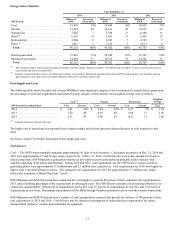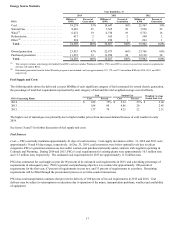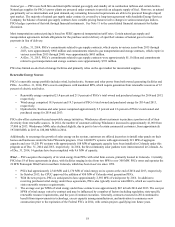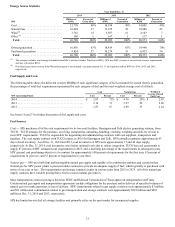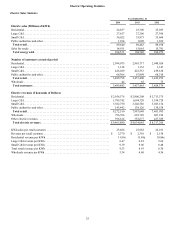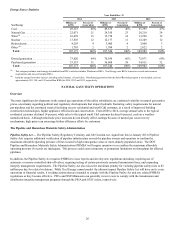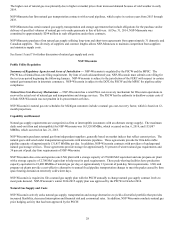Xcel Energy 2014 Annual Report Download - page 36
Download and view the complete annual report
Please find page 36 of the 2014 Xcel Energy annual report below. You can navigate through the pages in the report by either clicking on the pages listed below, or by using the keyword search tool below to find specific information within the annual report.18
Natural gas — PSCo uses both firm and interruptible natural gas supply and standby oil in combustion turbines and certain boilers.
Natural gas supplies for PSCo’s power plants are procured under contracts to provide an adequate supply of fuel. However, as natural
gas primarily serves intermediate and peak demand, any remaining forecasted requirements are able to be procured through a liquid
spot market. The majority of natural gas supply under contract is covered by a long-term agreement with Anadarko Energy Services
Company, the balance of natural gas supply contracts have variable pricing features tied to changes in various natural gas indices.
PSCo hedges a portion of that risk through financial instruments. See Note 11 to the consolidated financial statements for further
discussion.
Most transportation contract pricing is based on FERC approved transportation tariff rates. Certain natural gas supply and
transportation agreements include obligations for the purchase and/or delivery of specified volumes of natural gas or to make
payments in lieu of delivery.
• At Dec. 31, 2014, PSCo’s commitments related to gas supply contracts, which expire in various years from 2015 through
2023, were approximately $902 million and commitments related to gas transportation and storage contracts, which expire in
various years from 2015 through 2060, were approximately $685 million.
• At Dec. 31, 2013, PSCo’s commitments related to gas supply contracts were approximately $1.1 billion and commitments
related to gas transportation and storage contracts were approximately $723 million.
PSCo has limited on-site fuel oil storage facilities and primarily relies on the spot market for incremental supplies.
Renewable Energy Sources
PSCo’s renewable energy portfolio includes wind, hydroelectric, biomass and solar power from both owned generating facilities and
PPAs. As of Dec. 31, 2014, PSCo was in compliance with mandated RPS, which require generation from renewable resources of 12
percent of electric retail sales.
• Renewable energy comprised 21.4 percent and 21.9 percent of PSCo’s total owned and purchased energy for 2014 and 2013,
respectively.
• Wind energy comprised 18.9 percent and 19.3 percent of PSCo’s total owned and purchased energy for 2014 and 2013,
respectively.
• Hydroelectric, biomass and solar power comprised approximately 2.5 percent and 2.6 percent of PSCo’s total owned and
purchased energy for 2014 and 2013.
PSCo also offers customer-focused renewable energy initiatives. Windsource allows customers to purchase a portion or all of their
electricity from renewable sources. In 2014, the number of customers utilizing Windsource increased to approximately 41,000 from
37,000 in 2013. Windsource MWh sales declined slightly, due in part to loss of certain commercial customers, from approximately
197,000 MWh in 2013 to 188,000 MWh in 2014.
Additionally, to encourage the growth of solar energy on the system, customers are offered incentives to install solar panels on their
homes and businesses under the Solar*Rewards program. Over 24,000 PV systems with approximately 221 MW of aggregate
capacity and over 18,250 PV systems with approximately 188 MW of aggregate capacity have been installed in Colorado under this
program as of Dec. 31, 2014 and 2013, respectively. In 2014, the first community solar gardens were interconnected in Colorado. As
of Dec. 31, 2014, 14 gardens have been completed with 9.6 MW of capacity.
Wind — PSCo acquires the majority of its wind energy from PPAs with wind farm owners, primarily located in Colorado. Currently,
PSCo has 18 of these agreements in place, with facilities ranging in size from two MW to over 300 MW. PSCo owns and operates the
26 MW Ponnequin Wind Farm in northern Colorado, which has been in service since 1999.
• PSCo had approximately 2,340 MW and 2,170 MW of wind energy on its system at the end of 2014 and 2013, respectively.
• In October 2013, the CPUC approved the addition of 450 MW of Colorado wind generation PPA’s.
• With the new projects, PSCo is anticipated to have approximately 2,592 MW of wind power by 2016. In addition to
receiving purchased wind energy under these agreements, PSCo also typically receives wind RECs, which are used to meet
state renewable resource requirements.
• The average cost per MWh of wind energy under these contracts was approximately $45 in both 2014 and 2013. The cost per
MWh of wind energy varies by contract and may be influenced by a number of factors including regulation, state-specific
renewable resource requirements, and the year of contract execution. Generally, contracts executed in 2014 continued to
benefit from improvements in technology, excess capacity among manufacturers, and motivation to commence new
construction prior to the expiration of the Federal PTCs in 2014, with certain projects qualifying into future years.





